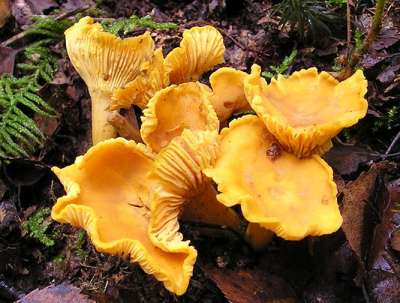
“Where should I look to find chanterelles?” someone asked the other day. And I said look on rich soil and poor soil, wet sites and dry sites, under hardwoods and under conifers. In other words, look everywhere. I know exactly how unsatisfying an answer this is because I’ve asked the same question of other mushroom hunters over the years and wrinkled my nose at their generic responses. And yet the more I’ve observed fungus, the more I’ve come around to shoulder-shrug answers. When I first started mushroom hunting I’d take mental notes of every flush I’d see – conditions, associated trees and understory plants, orientation, elevation, and then adopt the notes as revelation. Of course, then I’d inevitably come across something that directly contradicted what I’d supposed.
Great foragers enter the forest with a logical foundation of information, but then their hunts are guided more by intuition than anything else. I’m not a great forager, but I’m getting practiced enough to get a sense of how it’s done. You’ll walk and walk, covering a lot of ground fast because it doesn’t seem right. Then you’ll get to a spot that feels mushroomey, and you’ll slow down, and you’ll peer over every downed log, under every fern, and there the mushrooms will be. It’s not dissimilar to the way a practiced fisherman can read water he’s never fished before and intuit his way to trout.
If you’re looking for direct advice on how to improve your craft this will sound annoyingly mystic. Most of us received traditional educations where we were taught to accomplish tasks through concrete steps – the means to a specific end. We were given a blueprint, knowledge was doled out brick by brick, and we built our intellect like you’d assemble a wall. But this kind of thinking doesn’t translate all that well in the natural world. This traditional way of thinking is agrarian thinking – it’s why our forefathers and mothers cut down the forests and turned them into land they could cultivate. “Take this seed. Now do this and this and this and you’ll have food.” That order, that blueprint, was easy to practice and pass down. The native peoples didn’t think like this – “go to where the deer are; go to where this plant grows” – they’d honed their hunter-gatherer minds in an intuitive way.
My partner’s a teacher and she says that “synthesis” is a buzzword in education these days; basically, they’re trying to build and strengthen intuition in kids. They want to keep giving them their bricks, but they don’t want them to build walls that end up obscuring their views. Our European notions of learning have taught us to value order over feeling, but when a place feels mushroomey, it’s not that the forager’s mind has stopped working well, it’s that it’s working so fast the thinking seems unconscious. It’s taking all these disparate bits of data that were acquired from all these different experiences and synthesizing them into something applicable to the moment.
“So can this be taught?” I asked her. “Or is it just something you acquire through repeated exposure?”
“That’s the million dollar question,” she said.

